Green energy solutions for your home let you tap into renewable resources like solar, wind, and geothermal power. By installing solar panels, wind turbines, or heat pumps, you can reduce your utility bills and carbon footprint. Government incentives may help offset initial costs, making these options even more appealing. It's crucial to assess your energy needs and suitable installation locations. There's much more to explore about maximizing efficiency and savings with these solutions.
Key Takeaways
- Consider installing solar panels or building-integrated photovoltaics (BIPVs) to harness renewable energy and reduce utility costs.
- Evaluate energy-efficient heat pumps for effective heating and cooling, which can lower energy consumption.
- Assess available roof space and energy needs to determine suitable renewable energy systems for your home.
- Research government incentives and tax credits that can help offset the initial costs of green energy solutions.
- Upgrade to energy-efficient appliances and smart thermostats to maximize savings on energy bills.
Understanding Renewable Energy Sources
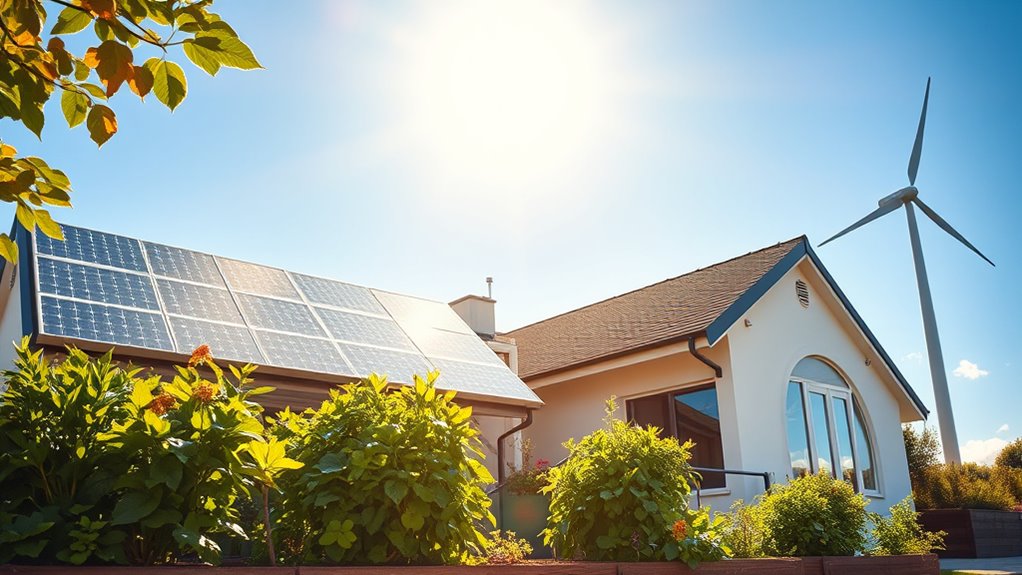
As you explore ways to power your home sustainably, understanding renewable energy sources becomes essential.
These sources, like solar, wind, hydropower, geothermal, and biomass, offer a path to lower your carbon footprint. Geothermal energy is particularly efficient as it leverages stable underground temperatures to provide heating and cooling, utilizing heat pump technology to optimize energy transfer. Solar energy captures sunlight through panels, while wind energy harnesses breezes using turbines. Solar-powered irrigation systems can enhance crop yields and efficiency, showcasing the versatility of solar energy applications.
Hydropower generates electricity from flowing water, providing a reliable energy source.
Geothermal energy taps into the Earth's heat, and biomass uses organic materials as fuel, making it versatile. Unlike fossil fuels, renewable energy is replenished faster than it's consumed, presenting a virtually inexhaustible option. Additionally, advanced materials in wind turbine design increase strength while reducing weight, enhancing efficiency in energy production.
Benefits of Implementing Green Energy
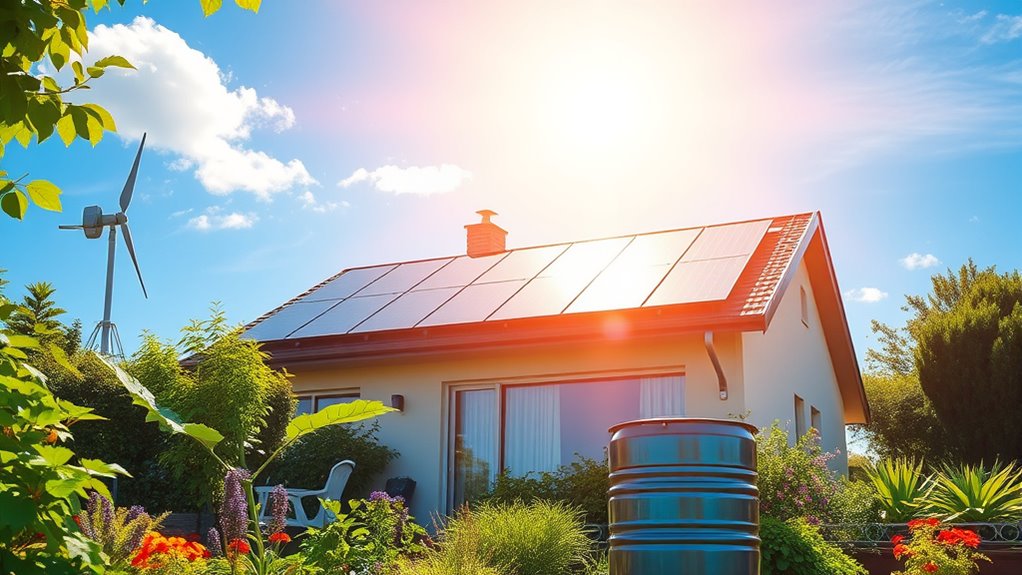
Implementing green energy solutions offers a range of benefits that extend beyond just environmental impact.
You'll notice a significant reduction in your utility bills, leading to long-term savings. Plus, various government incentives can help offset initial costs, making the transition more affordable. Additionally, choosing an energy-efficient heat pump can further decrease your energy consumption and costs.
Not only will your home become more valuable, but using durable, eco-friendly materials can save you money on maintenance and repairs over time. Additionally, incorporating hydrogen fuel cells into your energy system can further enhance efficiency and reduce reliance on traditional fossil fuels. By following risk management strategies in your investment decisions, you can ensure that your financial commitment to green energy remains sustainable.
Adopting green practices can enhance your lifestyle by improving your health and promoting energy independence. Your commitment to sustainable living can inspire your community, fostering engagement and awareness around environmental issues.
Ultimately, you're not just benefiting yourself but also contributing to a healthier planet for future generations. Moreover, advancements in renewable energy technologies are expected to increase efficiency by over 40%, further enhancing the benefits of your green investments.
Key Considerations for Installation
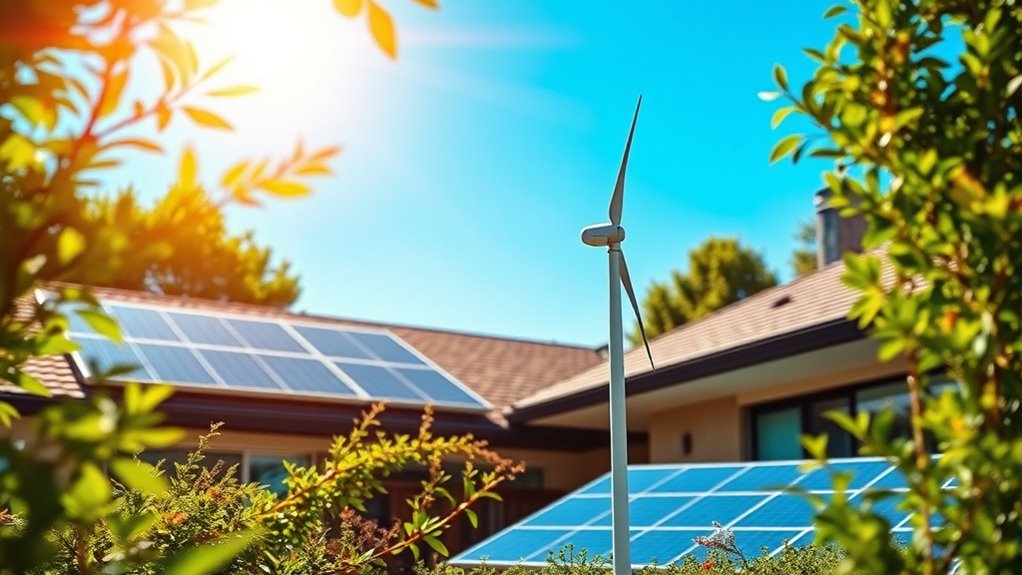
When considering the installation of green energy solutions, it's essential to carefully evaluate several key factors that can influence your system's performance and effectiveness.
Start by determining your energy goals—do you want to reduce grid reliance or offset costs entirely? Next, assess your available roof space for solar panels and understand your typical energy use patterns to size the system accurately. Additionally, consider the Seasonal Energy Efficiency Ratio (SEER) to ensure the heat pump you select operates efficiently. Choosing high-efficiency models can lead to better ROI over time. Furthermore, heat pumps can reduce energy bills by up to 50%, making them a financially sound investment for many homeowners.
Determine your energy goals and assess your roof space and energy use patterns to size your solar system effectively.
Don't forget to consider backup power needs during outages. Logistics matter too; ensure you select the right racking, mounting, and inverter.
Choose qualified contractors for safe installation, and always check local codes. Finally, budget for maintenance and understand warranty coverage to protect your investment long-term. Additionally, consider regular maintenance to ensure optimal performance of any heat pump system integrated into your energy solutions.
These considerations will help you achieve a successful green energy installation.
Recent Technological Advancements
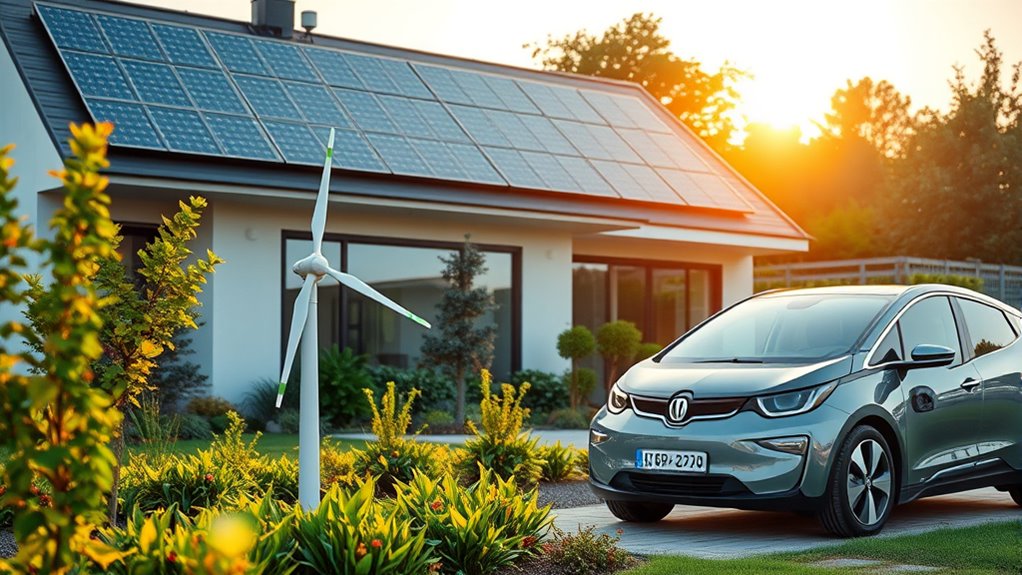
Installing green energy solutions lays the groundwork for tapping into the latest technological advancements that can enhance your home's energy efficiency.
For instance, thin-film solar panels offer improved durability and efficiency, while building-integrated photovoltaics (BIPVs) seamlessly blend energy production with your home's architecture. Additionally, incorporating heat pump systems can further optimize your home's energy usage by providing efficient heating and cooling solutions, which contribute to improving ventilation and overall indoor air quality. Furthermore, utilizing HEPA filters within your home can significantly reduce allergens, leading to a healthier living environment.
You can even engage in peer-to-peer energy trading through blockchain, making solar energy exchange decentralized. Smart inverters help integrate solar power into your electrical grid efficiently.
With solar plus storage systems, you can store excess energy for later use. Furthermore, automated energy management systems optimize usage, providing real-time monitoring and enhancing efficiency through smart appliances.
These innovations not only increase your home's energy performance but also contribute to a sustainable future. Furthermore, solar charge controllers play a critical role in regulating energy flow, ensuring the longevity of your battery systems.
Economic Factors Influencing Adoption

Understanding the economic factors that influence the adoption of green energy solutions is crucial for homeowners looking to make sustainable choices.
Access to finance, like loans or subsidies, can significantly impact your decision, especially if you're in a developing area. Government incentives, such as tax credits, can make renewable energy more appealing, while rising energy costs may encourage you to switch. Furthermore, having a solid budget plan can help homeowners manage the initial investment more effectively. Additionally, securing merchant account credit processing can provide financial flexibility for investing in green technologies. Additionally, state-specific benefits can enhance financial outcomes for homeowners considering renewable energy options.
However, high initial investment costs can deter some, particularly those with lower incomes. Over time, though, the return on investment from reduced energy bills can offset these expenses.
Awareness and education about renewables also play a role, as informed homeowners are more likely to embrace green alternatives, fostering a shift towards energy sustainability. Additionally, understanding tax implications of inherited IRAs can help homeowners better plan their finances when considering investments in renewable energy solutions.
Exploring Consumer Options
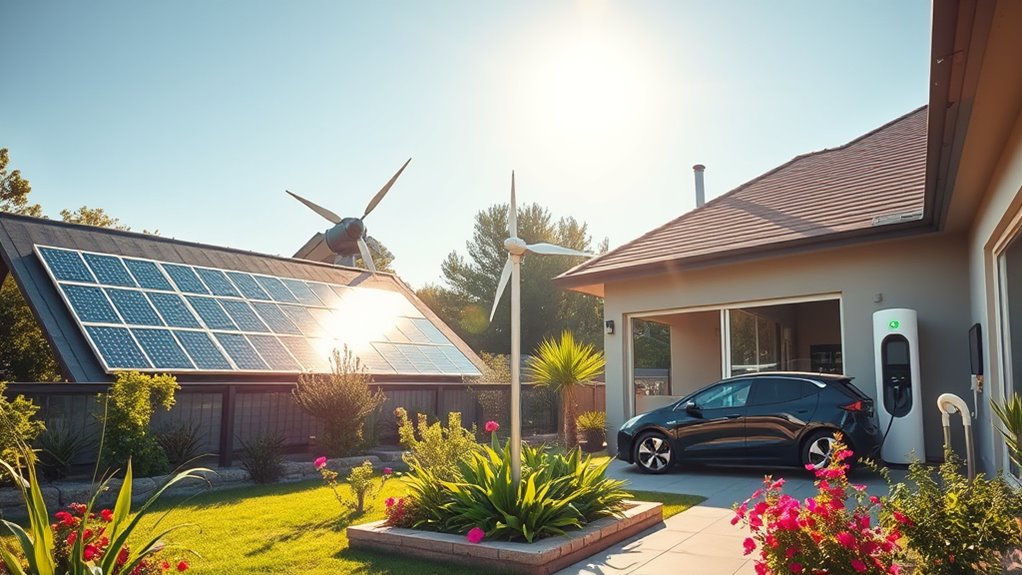
As you consider adopting green energy solutions, exploring consumer options becomes a key part of the process.
You'll find various renewable energy technologies, like solar panels and geothermal systems, that can fit your home's needs. Residential wind turbines and biomass systems also provide alternative energy sources, but they come with specific space and installation requirements. Heat pumps, for instance, are an efficient way to both heat and cool your home, utilizing renewable energy sources to enhance sustainability. Additionally, tiny houses often integrate green energy solutions effectively due to their smaller footprint and reduced energy needs. Building a tiny house can also take an average of 3 to 6 months, which allows for the incorporation of energy-efficient designs.
Moreover, many regions offer renewable energy suppliers and community solar programs, allowing you to choose providers focused on sustainability. Always evaluate contract terms and customer service when selecting a provider.
Assess your home's suitability, ensuring your roof or land can accommodate your chosen system. Understanding local regulations and hiring professional installers will ensure a successful implementation of your green energy solutions. Furthermore, considering long-term financial planning for these installations can help you make informed decisions about your investments.
Maximizing Efficiency and Savings
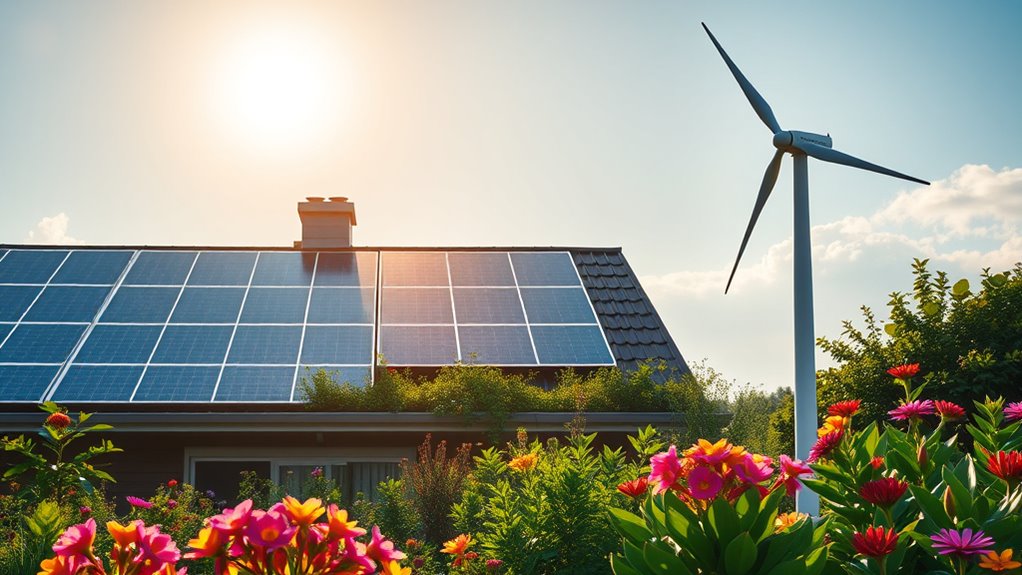
While transitioning to green energy solutions can seem daunting, maximizing efficiency and savings in your home is more achievable than you might think.
Start by upgrading to energy-efficient appliances; you could save around $500 annually. Proper attic insulation can cut energy bills by 10% to 50%, and utilizing smart thermostats can optimize your energy usage.
Consider solar panel installations too; they not only reduce bills but also increase your home's value by an average of 4.1%. Plus, with tax incentives available through the Inflation Reduction Act, you can offset costs of improvements.
Frequently Asked Questions
What Is the Lifespan of Solar Panels and Wind Turbines?
Solar panels typically last between 25 to 40 years, with monocrystalline panels often lasting longer. They degrade about 0.5% in efficiency each year.
Wind turbines usually have a lifespan of 20 to 25 years, but advancements are extending that.
Both require regular maintenance to ensure optimal performance and longevity.
Environmental conditions and installation quality also play vital roles in how long they'll function effectively, so keeping these factors in mind is essential.
How Do I Choose the Best Renewable Energy System for My Home?
Did you know that homes with solar panels can increase their property value by an average of 4.1%?
To choose the best renewable energy system for your home, assess your energy needs through load analysis and seasonal variations.
Evaluate your location for resource availability, like sunlight or wind consistency.
Consider the initial costs, potential energy savings, and local regulations.
Are There Financing Options Available for Green Energy Installations?
Absolutely, there are several financing options for green energy installations.
You can pay upfront with cash, which gives you full access to tax credits.
Alternatively, consider solar loans for manageable monthly payments, or leasing if you prefer a no-money-down option.
Power Purchase Agreements let you buy electricity at a fixed rate without owning the system.
Government-backed loans also provide competitive rates, making it easier for you to adopt renewable energy solutions.
Can I Install Renewable Energy Systems Myself, or Do I Need Professionals?
Picture yourself on a sunny weekend, tools in hand, ready to harness the power of the sun.
You can install renewable energy systems yourself, but it's not a walk in the park. You'll need to understand local codes, have some basic skills, and prepare for potential risks.
If you prefer peace of mind and efficiency, hiring professionals ensures optimal installation and compliance.
Weigh the benefits and risks before diving into your DIY adventure!
What Happens if I Produce More Energy Than I Consume?
If you produce more energy than you consume, you'll face several challenges.
Your inverters might overload, leading to potential damage or shutdowns. Excess energy could create inefficiencies, as it may not be utilized effectively.
Additionally, if the grid can't absorb your surplus, it could cause voltage fluctuations. Proper management and storage solutions are essential to optimize your energy use and avoid costly repairs, ensuring your system operates smoothly and efficiently.
Conclusion
By embracing green energy solutions, you're not just reducing your carbon footprint; you're also taking control of your energy costs. Imagine the satisfaction of powering your home sustainably while saving money each month. As you weigh the benefits against the initial investment, remember that today's advancements make it easier than ever to go green. You can transform your living space into an eco-friendly haven, reaping rewards for both the planet and your wallet. It's a win-win!









